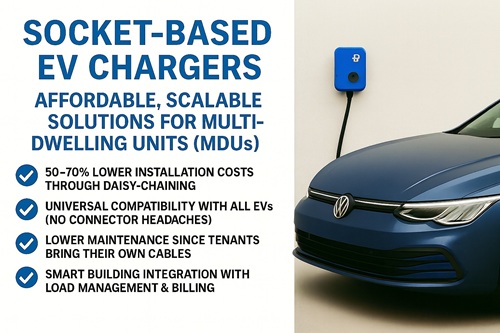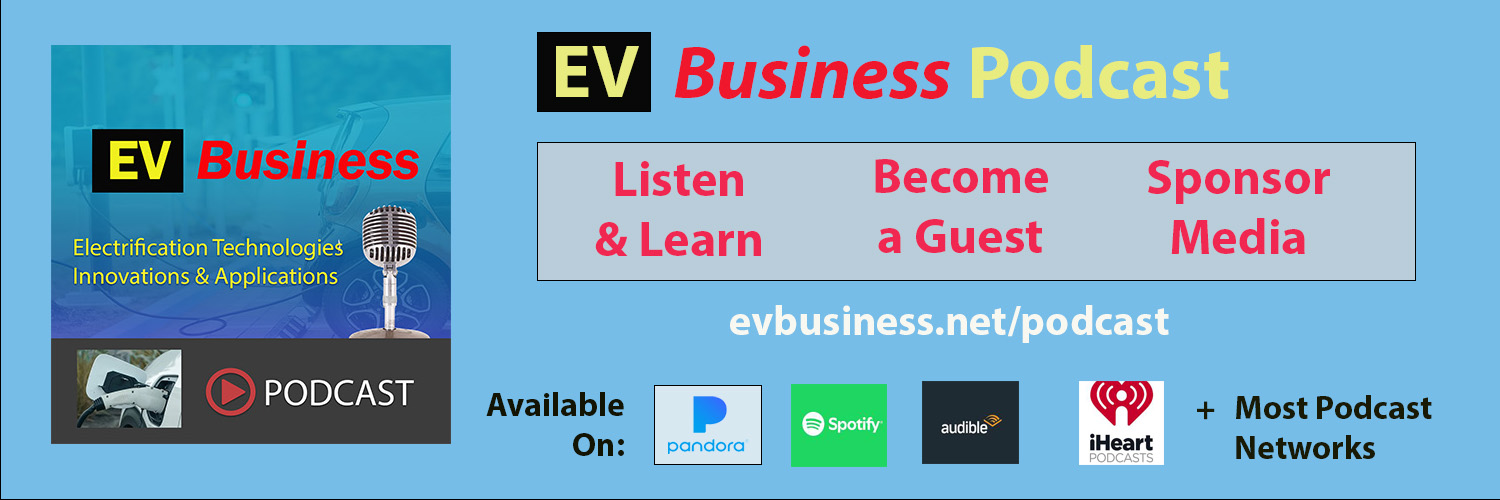By: Joseph Nagle
Owners and operators of multi-dwelling units face growing pressure to provide EV charging that is affordable, flexible, and easy to manage—but traditional corded chargers often fall short. A surprising benefit of plug-in chargers is that they are 30–40% smaller than wall-mounted cabled units, making installation simpler and more acceptable to landlords and property managers. This article explores key challenges—such as high upfront costs, limited electrical capacity, and the incompatibility of corded chargers with multiple EV connector types—that make charger selection so difficult for apartment and condo communities. Learn how Socket Based EV chargers can deliver universal compatibility, lower costs, and easier load management, helping multi-dwelling units meet resident demand while preparing for the future of mobility.

You want to discover more about Socket Based EV Chargers? Listen to the podcast session that this article summarizes – EVBusiness.net/113. Also available on Spotify, Pandora, Audible, iHeartRadio & other podcast networks.
What Are Socket-Based EV Chargers?
At their core, socket-based EV chargers are simply smart outlets. At Pando Electric, we’ve advanced this concept with connected devices that monitor building energy use, track consumption by driver, automate billing, and reimburse property owners. This approach transforms a simple outlet into a networked charging solution purpose-built for MDUs.
Why Socket-Based Chargers Lower Costs
The number one advantage is cost efficiency. Socket chargers are 50–70% less expensive to install because the National Electric Code allows daisy chaining, drastically cutting conduit and wiring expenses. Instead of running a dedicated line to every parking space, property owners can connect multiple chargers to a single breaker, reducing infrastructure costs by up to 5–10 times compared to “home run” installations.
Universal Compatibility Across EV Models
Another overlooked benefit is connector flexibility. Today, there are six different EV connector types in the U.S. and nine globally. Traditional corded chargers lock properties into one standard. Socket-based chargers use the NEMA 14-50 outlet, a universal interface. Drivers simply use their own cable, ensuring compatibility with any EV on the market without the property bearing connector risks.
Smarter Energy Management for Apartments
Socket-based chargers solve a common pain point: limited electrical capacity. Our devices create a self-healing wireless mesh network, allowing chargers to communicate and balance loads in real time. This makes it possible to expand charging access without costly transformer upgrades. Pando’s building-wide energy management ensures breakers never overload, distributing available power where and when it’s needed.
Reduced Maintenance and Downtime
Traditional corded chargers often fail due to cable damage — a repair that can take weeks and cost thousands. By eliminating permanently attached cables, socket-based systems avoid this problem altogether. Just as property managers don’t maintain wall outlets today, socket chargers provide a “set it and forget it” reliability. Drivers bring their own cables, which are easy to replace if damaged.
Easy Installation and Rapid Setup
Installation mirrors a standard electrical outlet, typically requiring just one to two weeks from start to finish. In sites with existing conduit, it can take as little as 20–30 minutes per unit. Once powered, outlets automatically form a local mesh network, connect to the management system, and begin reporting energy usage and availability.
Flexible Management and Integration
For property owners, management must be seamless. Pando’s system adds residents, tracks consumption, and bills drivers automatically. For those already using third-party software, our OCPP 2.0 compliance ensures interoperability. This flexibility allows socket-based chargers to complement existing charging infrastructure without disrupting established systems.
Where Socket-Based Chargers Fit Best
While Pando focuses on apartments and condominiums, socket-based chargers are also ideal in hotels, workplaces, and universities — essentially anywhere a vehicle remains parked for four or more hours. These environments benefit from lower cost, reduced complexity, and universal compatibility.
Additional Benefits for Property Owners
Socket-based EV chargers represent a major shift in how apartment and condo communities provide charging. By simplifying installation, reducing costs, and delivering universal access, they help property owners meet rising resident demand while preparing for the future of mobility.
– Lower operating costs thanks to reduced maintenance
– Revenue protection via built-in metering and billing
– Scalability without major electrical upgrades
– Future-proofing as EV adoption accelerates
– The Future of EV Charging at MDUs

About Joseph Nagle
Joseph Nagle is the Head of Corporate Strategy and a first hire at Pando Electric. He has over 10 years of leadership and development experience with EVs, EV charging, and distributed energy systems. Joseph was a first hire at EverCharge and Orange Charger, as well as a trusted employee at Samsung, Microsoft, and Nokia. His work at EverCharge was pivotal to the company being acquired by SK Group in 2022.


